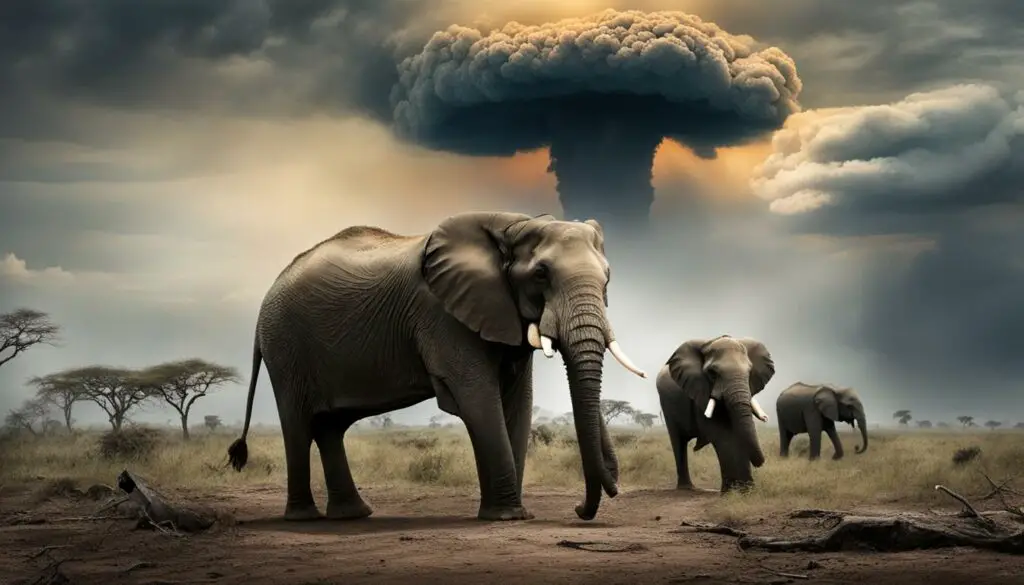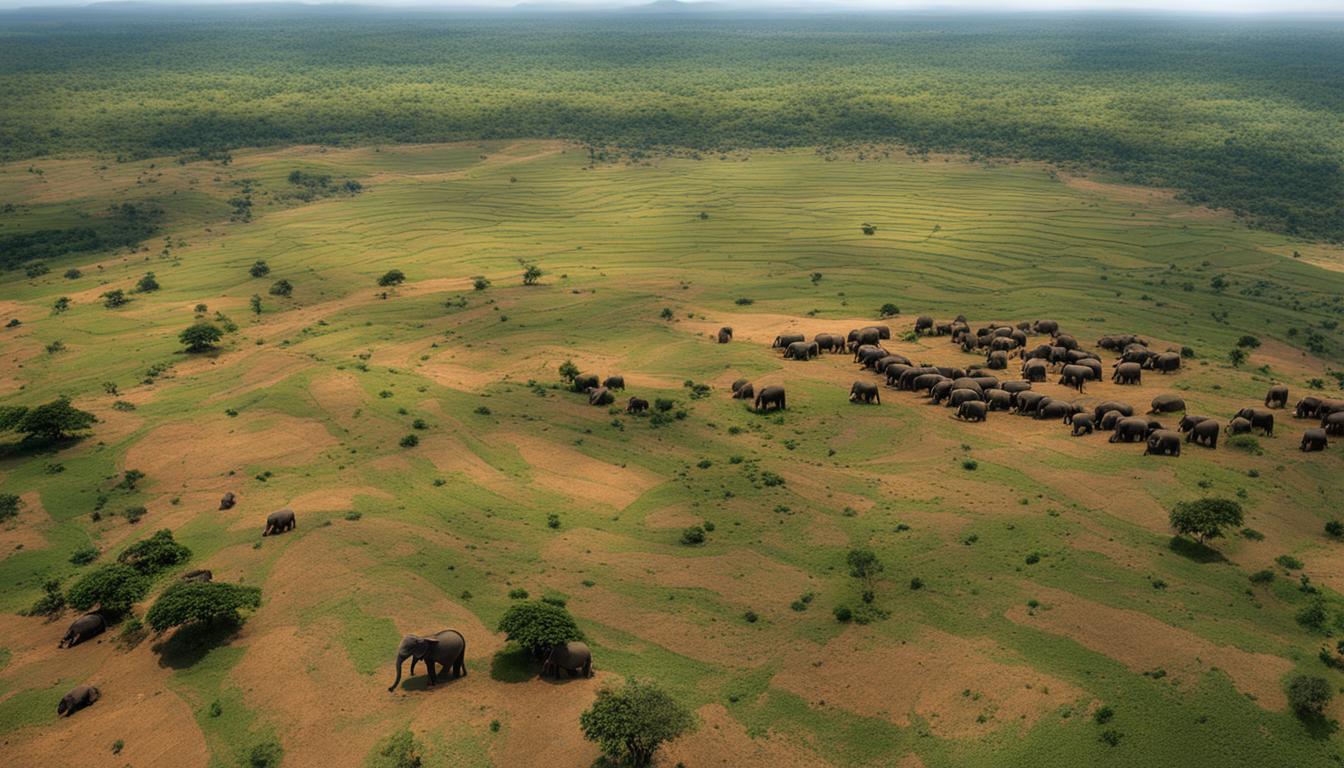Human-elephant conflict poses a significant threat to elephant populations. The expansion of human settlements and agricultural fields has led to the loss and degradation of elephant habitat, decreased connectivity between landscapes, and a decline in elephant populations.
This conflict arises as elephants are forced into closer contact with humans, resulting in crop raiding and loss of human and elephant lives. Efforts to mitigate and reduce conflict have focused on prevention and exclusion measures, as well as translocation or selective culling of elephants.
However, these approaches often only address the symptoms of conflict and fail to tackle the underlying drivers. To protect and conserve elephant populations, long-term solutions that consider both site-specific factors and landscape-level management are needed.
By mitigating and reducing elephant-human conflict, we can contribute to the conservation of these majestic creatures and ensure their coexistence with humans, leading to a more sustainable future for both elephants and our communities.
The Impact on Elephant Species’ Range and Ecology
Human activities have had a profound impact on the range and ecology of elephant species. Both African and Asian elephants have experienced significant habitat loss and fragmentation, leading to population declines. Asian elephants, once widely distributed, now occupy only 5% of their historic range, with populations scattered across fragmented habitats in 13 range countries. This has resulted in their classification as endangered. African elephants, with an estimated population of 550,000 to 700,000 individuals, face threats from poaching and habitat loss, making them vulnerable.
The consequences of habitat loss and fragmentation are far-reaching. Fragmentation disrupts the natural movement patterns of elephants, restricting their access to resources such as food, water, and mates. It also limits gene flow between isolated populations, reducing genetic diversity and potentially compromising the long-term viability of these species. The loss of habitat and decreased connectivity between landscapes have far-reaching implications for the overall health and survival of elephant populations.
To better understand the impact of human activities on elephant species, let’s look at a comparison between African and Asian elephants:
| Elephant Species | Range | Population Status |
|---|---|---|
| African Elephants | Sub-Saharan Africa | Vulnerable |
| Asian Elephants | Parts of Asia | Endangered |
As the table shows, both African and Asian elephants have experienced significant range contractions. This highlights the urgent need for conservation efforts to protect and restore elephant habitats, facilitate landscape connectivity, and ensure the long-term survival of these majestic creatures.
Causes and Consequences of Human-Elephant Conflict
The interaction between humans and elephants often leads to conflict, with detrimental consequences for both parties involved. Understanding the causes and consequences of human-elephant conflict is essential for finding sustainable solutions and safeguarding the well-being of both humans and elephants.
One significant cause of human-elephant conflict is the encroachment of human settlements and agricultural activities into elephant habitats. As human populations expand and compete for resources, elephants are often forced to venture into farmland in search of food, leading to crop raiding and substantial agricultural losses. This not only threatens the livelihoods of local communities, particularly small-scale farmers, but also exacerbates the conflict, as farmers may resort to retaliatory measures to protect their crops.
Furthermore, human-elephant conflict has severe consequences for both human and elephant lives. Crop raiding by elephants can result in the loss of essential food sources and income for farmers, deepening poverty levels in affected communities. Tragically, conflict-related deaths occur on both sides, with humans and elephants losing their lives during encounters. These incidents underscore the urgent need for effective conflict resolution strategies to prevent further human and elephant fatalities.
| Consequences of Human-Elephant Conflict |
|---|
| Loss of livelihoods for farmers due to crop raiding |
| Significant agricultural losses |
| Human fatalities |
| Retaliatory killings of elephants |
“Human-elephant conflict poses a significant threat to the well-being and survival of both humans and elephants. It is crucial to address the underlying causes of conflict and implement effective measures to mitigate its consequences. Only through peaceful coexistence can we ensure the conservation of elephant populations and the sustainable development of human communities.”
Efforts to mitigate human-elephant conflict have primarily focused on prevention and exclusion measures, as well as translocation or selective culling of elephants. However, these approaches often fall short in addressing the root causes of conflict and fail to promote long-term solutions. To achieve lasting resolutions, it is vital to consider site-specific factors, such as local cultural values and resource use decision-making, and incorporate them into conflict management models.
Additionally, adopting a landscape-level management approach is crucial for effective conflict management. By considering the broader ecological and sociocultural context of human-elephant interactions, strategic plans can be formulated to promote coexistence and minimize conflict. Such an approach requires collaboration among various stakeholders, including local communities, conservation organizations, and government agencies, to ensure the integration of diverse perspectives in conflict resolution efforts.
Strategies for Managing Elephant-Human Conflict
When it comes to managing human-elephant conflict, a combination of prevention and mitigation approaches is necessary. Traditional prevention measures such as electric fences, trenches, and noise deterrents can help keep elephants away from agricultural fields and human settlements. These physical barriers, combined with early warning systems and trained guards, can significantly reduce the occurrence of crop raiding and human-elephant encounters.
However, it is essential to address the underlying drivers of conflict and consider cultural values in conflict management strategies. Community-based conservation initiatives that involve local communities in decision-making processes can foster a sense of ownership and responsibility towards elephant conservation. By recognizing the cultural significance of elephants and the needs of local communities, conflicts can be better understood and resolved.
Mitigation approaches also play a vital role in managing human-elephant conflict. These approaches focus on minimizing the negative impacts of conflict when prevention measures fail. Translocating problem elephants to suitable habitats or implementing selective culling in extreme cases can help alleviate conflict situations. Additionally, compensating farmers for crop losses and promoting alternative livelihood options can reduce economic dependence on agriculture, reducing the incentive for retaliation against elephants.
Benefits of Landscape-Level Management
Implementing landscape-level management plans is crucial for the long-term sustainable management of human-elephant conflict. These plans take into account the ecological needs of elephants and the socioeconomic needs of local communities, ensuring a balanced approach to conservation. By integrating scientific research, community engagement, and land-use planning, landscape-level management can identify key elephant habitats, establish corridors for elephant movement, and minimize the fragmentation of landscapes.
| Benefits of Landscape-Level Management: | Key Strategies: |
|---|---|
| Promotes connectivity between fragmented elephant habitats | Identifying and protecting elephant corridors |
| Reduces human-elephant conflict incidents | Implementing early warning systems and trained guards |
| Conserves biodiversity and ecosystem services | Integrating landscape-level conservation plans with existing protected areas |
| Facilitates sustainable land-use practices | Supporting alternative livelihood options for local communities |
By adopting a comprehensive approach that combines prevention and mitigation measures, considers cultural values, and emphasizes landscape-level management, we can effectively manage human-elephant conflict and promote the coexistence of humans and elephants. This integrated approach ensures the long-term conservation of elephant populations while protecting the livelihoods and well-being of local communities.
“The key to managing human-elephant conflict lies in understanding the needs of both elephants and people. By addressing the underlying causes and involving local communities in the decision-making process, we can pave the way for peaceful coexistence.”
The Impacts on Elephant Populations and Conservation Efforts
Human-elephant conflict has had severe impacts on elephant populations, contributing to the decline of both African and Asian elephants. These magnificent creatures are now listed as endangered and vulnerable, respectively. The loss of elephant lives, habitat damage, and poaching for the illegal ivory trade further threaten their survival.
According to recent studies, the African elephant population has experienced a decline of approximately 30% over the past decade, mainly due to habitat loss and poaching. This decline is alarming, as elephants are integral to maintaining the biodiversity and ecological balance of their habitats.
Furthermore, the ivory trade continues to pose a significant threat to elephant populations. Despite efforts to combat this illegal trade, the demand for ivory remains high in some regions. This demand drives poaching activities, resulting in the brutal killing of elephants for their tusks.
Conservation efforts have expanded to address the various threats facing elephants. Organizations and governments are implementing measures such as anti-poaching patrols, community-based conservation initiatives, and habitat restoration projects. These initiatives aim to protect elephant populations, promote coexistence with humans, and reduce the illegal ivory trade.
| Impacts on Elephant Populations | Conservation Efforts |
|---|---|
| The decline of both African and Asian elephants | Anti-poaching patrols |
| Habitat loss and fragmentation | Community-based conservation initiatives |
| Loss of elephant lives | Habitat restoration projects |
| Poaching for the illegal ivory trade | Reducing demand for ivory |
Protecting elephants and promoting coexistence with humans are essential for their conservation. Long-term solutions that prioritize both the ecological needs of elephants and the well-being of human communities are crucial for the sustainable management of elephant populations.

The Importance of Conservation Efforts
Conservation efforts play a vital role in safeguarding elephant populations. These efforts not only protect the elephants themselves but also help to preserve the fragile ecosystems they inhabit. By preserving elephant habitats and addressing the underlying causes of human-elephant conflict, we can create a sustainable future for both elephants and the communities that rely on their ecosystems.
Conclusion
Resolving elephant-human conflict and achieving peaceful coexistence with these magnificent creatures requires a holistic approach. By addressing the underlying drivers of conflict, integrating cultural values, and adopting sustainable land management strategies, we can work towards a future where humans and elephants can peacefully coexist.
To effectively mitigate and resolve human-elephant conflict, it is crucial to consider site-specific factors and promote long-term solutions. This includes implementing landscape-level management strategies that take into account the needs of both elephants and human communities. By prioritizing sustainable land management decisions, we can create a harmonious balance between conservation efforts and the well-being of local people.
It is essential to understand that protecting elephants and their habitats not only contributes to biodiversity conservation but also fosters positive relationships between humans and these gentle giants. With a comprehensive approach that embraces coexistence, we can ensure the survival of elephant populations and create a future where humans and elephants thrive side by side.
Embrace Elephant-Human Coexistence Through Sustainable Land Management
As we move forward, it is important to continue exploring innovative strategies for elephant-human conflict resolution. By integrating scientific knowledge, local wisdom, and cultural values, we can develop sustainable solutions that promote coexistence and safeguard the future of both elephants and humans.
Remember, the key to success lies in our collective efforts. Let us work together to create a world where elephants roam freely, and humans can peacefully coexist with these extraordinary beings. By prioritizing sustainable land management and fostering harmonious relationships, we can ensure that future generations will continue to marvel at the majesty of elephants in their natural habitats.
What Role Have Famous Elephants Played in Wildlife Conservation Efforts?
Famous elephants have played a significant role in unforgettable journeys of wildlife conservation. Their presence and captivating stories have raised awareness about the importance of protecting wildlife habitats and conserving endangered species. These elephants have become ambassadors, inspiring people worldwide to contribute to the preservation of our planet’s remarkable biodiversity.
FAQ
What is human-elephant conflict and how does it impact elephant populations?
Human-elephant conflict refers to the conflict that arises when elephants are forced into closer contact with humans, often resulting in crop raiding and loss of human and elephant lives. This conflict poses a significant threat to elephant populations by causing habitat loss, decreased connectivity between landscapes, and a decline in elephant numbers.
How does human-elephant conflict affect the range and ecology of elephant species?
Human-elephant conflict leads to habitat loss and fragmentation, which has significantly impacted both African and Asian elephant populations. Asian elephants now occupy only 5% of their historic range, while African elephants face threats from poaching and habitat loss. Protecting the range and ecology of these species is crucial for their conservation.
What are the causes and consequences of human-elephant conflict?
Human-elephant conflict arises from factors such as encroachment of human settlements and agricultural activities into elephant habitat, competition for resources, and climate change. The consequences include crop raiding, resulting in agricultural losses and the loss of livelihoods for farmers, as well as human fatalities and retaliatory killing of elephants.
How is human-elephant conflict managed?
Current approaches to managing human-elephant conflict focus on prevention through exclusion measures and on-site deterrents, as well as mitigation through translocation or culling of elephants and compensation for losses. However, these approaches only address the symptoms of conflict. Addressing the underlying drivers and integrating sociocultural factors into conflict management models are crucial for effective management.
What are the impacts of human-elephant conflict on elephant populations and conservation efforts?
Human-elephant conflict contributes to the decline of both African and Asian elephant populations, which are listed as endangered and vulnerable, respectively. The loss of elephant lives, habitat damage, and poaching for the illegal ivory trade further threaten their survival. Conservation efforts aim to protect elephants and promote coexistence with humans for their sustainable management.
How can we resolve human-elephant conflict and achieve coexistence with elephants?
Resolving human-elephant conflict requires a holistic approach that addresses the underlying drivers, integrates cultural values and sociocultural considerations, and adopts landscape-level management strategies. By considering site-specific factors, promoting sustainable land management, and prioritizing the needs of both elephants and human communities, long-term solutions can be developed to mitigate conflict and conserve elephant populations.











